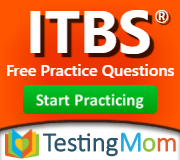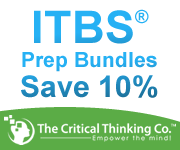ITBS Guide
| ITBS Summary
|
|
|---|---|
| What: ITBS is a standardized test. | |
| Who: Students in grades K-8 | |
| Where: Tests are administered in the fall or spring of the school year. | |
| When: Answers are in response to oral or written questions. | |
| How: Pencil and paper | |
| Type: The test is often used to measure a student’s yearly progress. | |
| Why: 30 minutes for each test | |
| Time: English | |
| Language: English | |
| Preparation: Students should become familiar with the test’s purpose and format. | |
| Cost: No cost is assessed to the student. | |
By: Erin Hasinger, Tests.com
The Iowa Test of Basic Skills (ITBS) is a standardized achievement test for students in kindergarten through eighth grade. The test is tailored specifically for different grade levels. Developed by the College of Education at the University of Iowa, the ITBS is used to monitor year-to-year progress and can help supplement teachers in their observations about student capabilities, such as what a student’s most and least developed skills are. The ITBS has been in use since 1935.
The test is available at different levels for students at different grade levels. The batteries aim to help determine how prepared students are for academic instruction, what individual accommodations may be necessary, which students may require early intervention, and to determine each student’s individual baseline of achievement. Questions are delivered orally by the teacher and response options are pictures, words or numerals, as appropriate. Approximately 30 minutes are given for each test.
The Level 5 Battery is given to children in kindergarten. It emphasizes early childhood academic skills, such as listening vocabulary and math, and assesses how prepared a child is cognitively to begin the academic curriculum. Level 6 is given to students in the fall and midyear of first grade and is similar to Level 5, though it also includes an optional reading test for those students who are ready to have their literacy skills assessed.
Levels 7 and 8 evaluate student skills in language arts (vocabulary, word analysis, reading comprehension and spelling), mathematics, social studies, science, and sources of information (such as alphabetizing or using a map) and are used to measure how well each student is progressing in the curriculum. Level 7 is used in the spring of first grade and fall of second grade, while Level 8 is administered in the midyear and spring of second grade and occasionally in the fall of third grade.
Levels 9 through 14 are aimed at students in third through eighth grade and assess skills in language arts, including vocabulary, reading comprehension, spelling, capitalization, punctuation, usage and expression; math computation, problem solving, data interpretation, concepts and estimation; social studies; science; maps and diagrams; and reference materials. The Level 9 test also includes questions about word analysis and listening.
Level 9 is given to third graders, and each successive grade takes the next level exam. For example, fourth graders are given Level 10, fifth graders are given Level 11, and so on.
Students can prepare for the test by understanding the purpose of the test is to measure year-to-year progress. Teachers can help students become familiar with the test format and help allay feelings of anxiety.
Test results yield three different scores: a raw score, percent correct, grade equivalent, developmental standard score and percentile rank. Generally, the raw score and percent correct scores are converted to form scores that can accurately assess a student’s performance. Scores may be delivered in reference to state or national norms or in reference to criterion standards.
Test packets are available from the Iowa State Department of Education, Riverside Publishing or from a school’s local education agency. Parents of home schooled students can obtain test kits from their local public school district.
To see a listing of products and services for the ITBS, see our ITBS directory.
Sources: University of Iowa, Riverside Publishing





